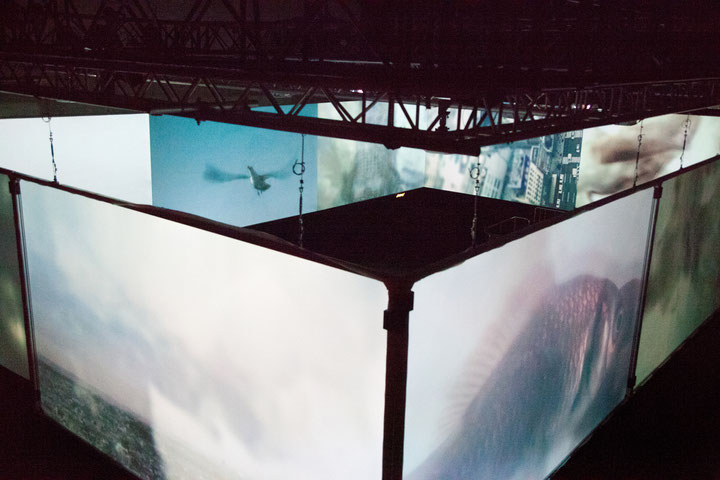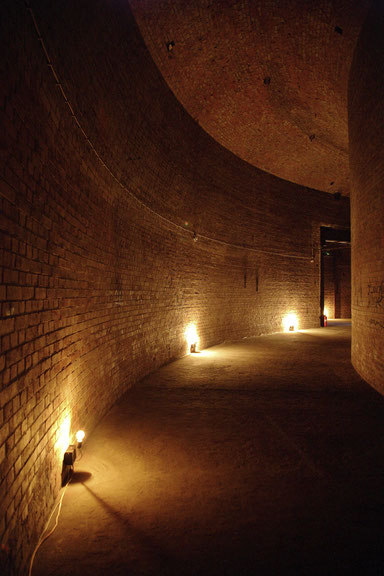Issue 1/2012 - Net section
Immersive sound show
The CineChamber makes a stop-over at the steirischer herbst’s musikprotokoll
It sounds like arthouse cinema, but is actually a series of events under the aegis of the musikprotokoll section at the steirischer herbst festival, which will display a new technology for presenting sound and images on four consecutive days in Graz’ Dom im Berg.
Recombinant Media Labs and its founder Naut Humon are the developers behind CineChamber, currently presented at a whole series of festivals as part of the ECAS/ICAS (European and International Cities of Advanced Sound) network. A room eight metres by twelve, raised as a podium at the Dom im Berg venue, surrounded by ten screens with an 8.8.2. multi-channel sound system, forms an audiovisual instrument that lets you walk around inside it, an electronic studio which – as Humon puts it – is meant to serve as a lab within the festival. It was all preceded by workshops, in which compositions with both auditory and visual strata were created. For the Graz presentation the construction was set up beforehand in a studio in the ORF Styrian Regional Studio, where the artists had plenty of time to develop their compositions. For musikprotokoll, works were commissioned from Werner Dafeldecker and Lawrence English, jade&pita, subshrubs and Edwin van der Heide: these were developed during the workshop, with their world premieres on 6th October at the inaugural concert together with Naut Humon’s »Man with a Movie Theatre« – a homage to Austrian experimental filmmaker Peter Tscherkassky. Over the next few days, screenings showed both the new works and pieces from the CineChamber archive.
The lab-within-a-festival dimension was incorporated by having the artists working live during the opening, providing an opportunity for them to make changes or expand their work during the concert. The room is kept in complete darkness – not hard to achieve in the case of Dom im Berg, as it is a cave-like space within the tunnel system beneath Graz’ Schloßberg, where the only light came from the projections on the screen – and this offers scope for concentrated listening and a heightened experience of the interplay of sounds and images.
The four commissioned works are extremely different. The piece by Werner Dafeldecker and Lawrence English, »the cold monolith« (2010/11), addresses the extreme living conditions in the Antarctic. The images and sound materials are all from recordings made in and around two research stations, Marambio and Esperanza. Desolate, barren landscapes appear, with the focus on the unpitying harshness of nature, ice and cold.
Choreography, a notion from the performing arts, lies at the heart of »untitled (noctilucence)« (2011) by jade&pita. The two artists take a natural phenomenon as their point of departure, showing an atmospheric composition made up of abstract images and sounds, which culminates in a flicker sequence.
The international collective subshrubs were invited to the opening concert almost as if they were a chamber orchestra. The four artists, positioned outside the CineChamber, provided the musical accompaniment for their images. The concept for »A Journey into the Mind of P.P.« (2011) was rooted in the idea of transforming the flow of energy through the brain of a surreal genius figure called »P.P.« into a musical and optical mode. They added new energy flows to this, heightening the sense of a fictitious utopian reality.
Transferring sound into a spatial dimension is the underlying concept in Edwin van der Heides’ oeuvre, making it almost compulsory for him to be included in this festival section. »DSLE1« (2010/11) reflects this specific kind of construction, with the audience in the centre surrounded by screens. In his piece Van der Heide deploys the latest technologies, such as LEDs, to give the audience an opportunity to experience light spatially and temporally, in a manner akin to the sounds he utilises.
Generally speaking, the particular, immersive dimension of the CineChamber stems from the way in which the images, moving rapidly at times and forming mobile staccato-style panoramas, surround the audience, adding new dimensions to their perception of the sounds and music. The spatially closed configuration is thus based on an open principle of construction, and its experimental character will in all probability be preserved when other works are presented within this frame.
musikprotokoll at the steirischer herbst festival, 6th to 9th October 2011, Dom im Berg, Graz.
http://rml-cinechamber.org/
Translated by Helen Ferguson

